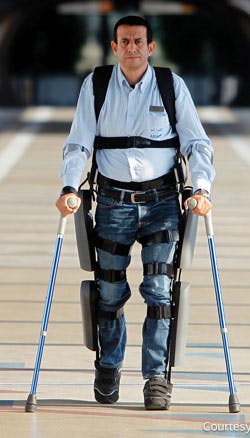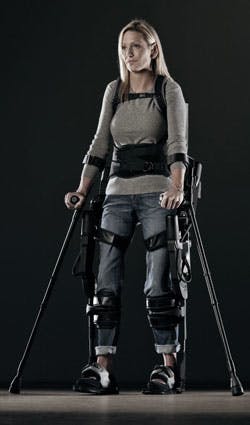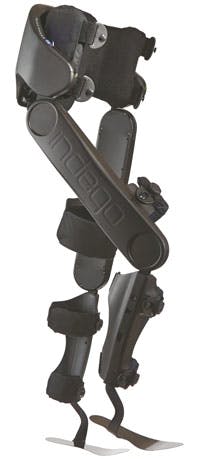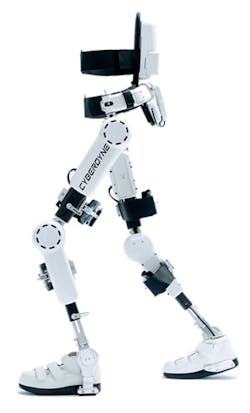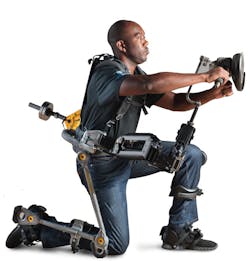This file type includes high resolution graphics and schematics when applicable.
Today's exoskeletons are a far cry from Marvel’s Iron Man, but Tony Stark had the advantage of an arc reactor and almost unlimited power. Iron Man also has powerful servos and armor that gods and aliens have a hard time cracking.
Medical applications include support for rehabilitation and gait training, as well as providing long-term mobility. The Japanese Orthopedic Association (JOA) refers to musculoskeletal disorders as Musculoskeletal Ambulation Disability Symptom Complex, or MADS. This encompasses patients with spinal cord or traumatic brain injuries, cerebrovascular diseases, diseases of the brain, and neuromuscular system problems.
1. Pictured are the offerings from ReWalk Robotics (above left) and Ekso Bionics.
Exoskeletons have many advantages over other alternatives, like medical scooters (such as the one my father uses). An exoskeleton moves the limbs, allowing the user to stand upright rather than sit. It also allows users to navigate areas like steps that a scooter cannot. Some systems can also allow paraplegic users to walk. Of course, a scooter tends to be more power-efficient and it can incorporate a significantly larger battery. They are also much less expensive than the current crop of exoskeletons.
Many medical exoskeleton platforms are part of the medical Internet of Things (IoT), with wireless communication used to do everything from monitoring a user’s progress to configuring the capabilities and operation of the exoskeleton. Many systems allow this to be done using a smartphone or tablet.
Part of the system design challenge is to provide support for doctors and therapists, as well as users. Some systems will be employed in a rehabilitation setting, while others will be used for personal mobility augmenting or replacing wheelchairs or other devices.
ReWalk Robotics’ ReWalk Personal System (Fig. 1), Ekso Bionics’ Esko (Fig. 1), Parker Hannifin’s Indego (Fig. 2) and Cyberdyne’s HAL (Hybrid Assistive Limb) (Fig. 2) address medical applications. All have a similar architecture, with an external frame that is attached to the operator using Velcro belts and shoes. This configuration allows the frame to help support the operator, as well as provide feedback to the system. The battery and control system are usually found in a pack on the back of the upper portion of the system.
Servos such as accelerometers are found in the joints and sensors, and are located throughout the systems. Feedback systems vary among devices. For example, Cyberdyne’s HAL detects bio-electric signals (BES) generated by the brain to control muscles. Sensors are attached to the skin to detect BES so the exoskeleton knows what the desired movement is.
ReWalk Personal System was approved by the FDA in June 2014. Clinical trials are in progress for the other platforms. These system are often combined with arm crutches allowing a user additional support and movement control. This will depend on the user’s requirements and capabilities.
Part of the design and deployment challenge is the size range of the operators. Weight and height are key factors for delivering multiple configurations or adjustable designs. Operating time varies, but is on the order of a few hours.
Ekso Bionics has a feature called Variable Assist which allows clinicians to control the system’s augmentation based on a patient’s strengths and limitations. It allows weaker patients to become more stable quickly. The Adaptive Assist allows the system to dynamically adjust its support so the user has a smooth and consistent gait. The Fixed Assist provides a fixed amount of power, and it is usually configured based on data acquired using the Adaptive Assist.
For initial training, Ekso’s FirstStep allows clinicians to initiate actions like steps. ProStep support is used as patients progress so they can adjust their hips forward and move them laterally as more natural movement is achieved.
Parker Hannifin’s Indego uses vibratory feedback to indicate balance and LED indicators to provide status, along with a mobile app to help with gait learning and teaching. The system uses postural cues to help mimic natural movement, including actions like leaning forward when standing up. The entire system breaks down to fit inside a rolling suitcase.
Medical use of exoskeletons is more demanding than exoskeletons that simply enhance movement; not only must they must track the user’s movements, but they also must provide correction or assistance to improve the user’s movement. The exoskeletons also provide significantly more feedback to clinicians and doctors so they can track a patient’s progress.
This file type includes high resolution graphics and schematics when applicable.
Exoskeleton Research
Download this article in .PDF format
This file type includes high resolution graphics and schematics when applicable.
Exoskeleton research is pervasive, and firms like Hyundai Motor Company are pushing the envelope. They are using tools like National Instrument’s LabVIEW to design the control systems. The Hyundai Wearable Robotics for Walking Assistance system is controlled by a Single Board RIO. The RIO architecture is based around an FPGA that proved valuable during the design process—the architecture changed several times, including drastic changes in the control architecture and sensor system. The new sbRIO-9651 System on Module (SOM) helped reduce the weight of the system by 10 kg while maximizing the battery efficiency.
3. The HULC (Human Universal Load Carrier) uses hydraulics to provide heavy lifting capabilities.
The Hyundai design consists of two modules that can be used together or independently. These include Hip Modular Exoskeleton and the Knee Modular Exoskeleton.
The HULC (Human Universal Load Carrier) (Fig. 3) is a joint research project between Berkeley Robotics and Human Engineering Laboratory, Ekso Bionics, and Lockheed Martin for the U.S. Army Natick Soldier Research Development and Engineering Center (NSRDEC). It is designed to help soldiers carry up to 200 lb of gear while reducing strain on the body. HULC needed to address rugged environments including sand, wind, rain, and extreme temperature and humidity conditions.
The HULC’s anthropomorphic design used hydraulics to provide lift. The on-board computer handles input from sensors and control of the hydraulic system. The system was designed in a modular fashion so components could be easily replaced in the field. The system was also designed to support the full load even when battery power was low or exhausted.
Taking the Load
Providing mechanical assists to people can be done in a number of ways. For example, General Motors and NASA developed RoboGlove to help grip tools and objects (see "Electromechanical Medical Marvels"). This can help prevent problems such as cramps and repetitive stress, since the glove provides the compression instead of fingers.
Lockheed Martin’s FORTIS (Fig. 4) is a mechanical engineer’s dream. The unpowered exoskeleton is designed to offload the weight of heavy tools up to 36 pounds to reduce the stress on the operator. The U.S. Navy is interested in it to help with shipbuilding. The mechanical linkages transfer the load of the tools to the ground. The operator simply repositions the frame. Counterweights and support points allow tools to be used almost as if the operator was in a weightless environment. A zeroG Arm is attached to the thigh portion of the frame, and the tool is attached to a gimbal on the arm. The technology is very similar to that used in the Steadicams that are often found on movie sets and filming of sporting events.
The advantage of FORTIS is that it reduces muscle fatigue by up to 300 percent, thereby increasing productivity. It can also reduce the number of accidents that often occur when heavy equipment is being used.
Exoskeleton development is continuing. Look for reduced cost, increased capabilities, and a wider range of applications. Medical applications remain a key focus for many companies, but challenges remain in approval, availability, and cost.
This file type includes high resolution graphics and schematics when applicable.
About the Author
William G. Wong
Senior Content Director - Electronic Design and Microwaves & RF
I am Editor of Electronic Design focusing on embedded, software, and systems. As Senior Content Director, I also manage Microwaves & RF and I work with a great team of editors to provide engineers, programmers, developers and technical managers with interesting and useful articles and videos on a regular basis. Check out our free newsletters to see the latest content.
You can send press releases for new products for possible coverage on the website. I am also interested in receiving contributed articles for publishing on our website. Use our template and send to me along with a signed release form.
Check out my blog, AltEmbedded on Electronic Design, as well as his latest articles on this site that are listed below.
You can visit my social media via these links:
- AltEmbedded on Electronic Design
- Bill Wong on Facebook
- @AltEmbedded on Twitter
- Bill Wong on LinkedIn
I earned a Bachelor of Electrical Engineering at the Georgia Institute of Technology and a Masters in Computer Science from Rutgers University. I still do a bit of programming using everything from C and C++ to Rust and Ada/SPARK. I do a bit of PHP programming for Drupal websites. I have posted a few Drupal modules.
I still get a hand on software and electronic hardware. Some of this can be found on our Kit Close-Up video series. You can also see me on many of our TechXchange Talk videos. I am interested in a range of projects from robotics to artificial intelligence.

